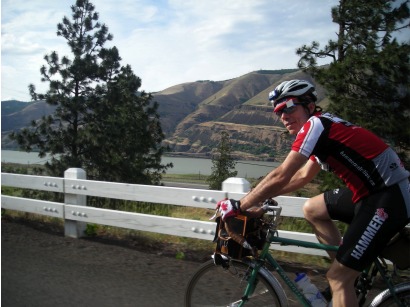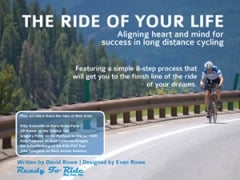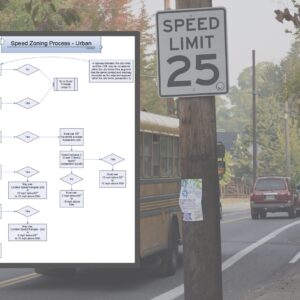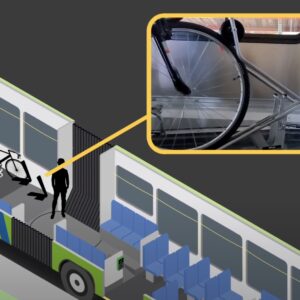
Portland’s David Rowe is a long-distance biking expert. What makes someone an expert in pedaling all day long? First, you’ve got to put in the miles (David has done that). Then, you could do things like moderate a panel on endurance riding at the North American Handmade Bicycle Show (David has done that) and maybe publish a blog devoted to long-distance riding (yep, that too). But, to really be an expert, you’ve got to write a book. With the release last month of The Ride of Your Life: Aligning heart and mind for success in long distance cycling, David has done that too.
“I remember, as a kid, being absolutely stoked with the freedom that came when I got my first good bike. I would pack a sandwich, put my transistor radio in my shirt pocket, and just roll. I was always in hot water with my mom for riding too far from home.”
Now, David is on a virtual book tour to spread the word about this excellent e-book and resource and BikePortland.org was chosen as one of the stops.
Below is a Q & A with David Rowe. I asked him (via email) all about this book and the long-distance cycling scene.
First, tell us a bit about yourself. What is you bikeground?
I’ve been wrenching on bicycles and riding long since I was eight years old. No kidding, I remember, as a kid, being absolutely stoked with the freedom that came when I got my first good bike. I would pack a sandwich, put my transistor radio in my shirt pocket, and just roll. I was always in hot water with my mom for riding too far from home.
Like a lot of Californians, my wife and I moved to Portland to improve our quality of life. I knew about the surfing in the region; I had been to the Oregon Coast many times. But I really wasn’t aware of the outrageous cycling so close the city. I joined the Portland Wheelmen and began riding in the Willamette Valley, the Gorge, and the Cascades.

The organized rides were a big attraction at first. But over time, I felt they had become too big. There were way too many crashes. From where I sit, the huge event rides are the downside of living in cycling city USA.
Fortunately, I became aware of randonneuring through a couple of Wheelmen. Del Scharffenberg was riding these incredible distances in a single day. At first, I said, ‘no way!’ But I finally decided to try it and I fell in love with it. Not only did the randonneurs teach me how to become self-sufficient, they introduced me to epic routes, and they taught me how to ride solo, all day long, with confidence. Today, it’s pretty rare that I ride with someone unless I’m in a brevet. That’s critical if you’re going to train for ultradistance cycling.
BikePortland readers come from just about every bikeground you can think of. Which of them would find something interesting/useful in your book?
I wrote The Ride of You Life for riders like me – folks who may never have raced a bicycle, but enjoy the feeling of riding long and riding hard, and who connect a long, hard ride with a sense of accomplishment.
“Anyone who has ever thought about riding a century will find value in this book.”
Anyone who has ever thought about riding a century will find value in this book. Riding 100 miles in a single day is a milestone that may riders strive for. Most of them will attempt it through an organize ride, and most of the best supported riders are fund raisers, where the purpose of the ride is baked-in. Some will complete a ride like Reach the Beach, and check it off their list, and move on. Others will wonder, what’s next? And then they’ll start looking for it.
Again, in the Northwest, it’s not hard to find epic rides of 100 miles or more. What’s not so easy, though, is finding the motivation to prepare for a ride like STP, especially if you are going to do it in one day. The Ride of Your Life won’t tell you how to train for STP, or S2S (Seattle to Spokane), but it will help you get very clear about why you are doing it, to help you gain the confidence that you can do it, and to help you find the commitment to finish it should the going get rough, and it can get rough.
For many weekend warriors, or for folks whose longest ride is to and from work, the idea of spending the better part of a day in the saddle is something that might sound appealing, but it can be hard to really grasp mentally. Are there some basic steps (both mental and/or physical) folks can take to go from regular, Joe-commuter to more of an endurance rider?
“Many of the Oregon brevets start in Forest Grove. Many riders take the MAX line out to Hillsboro Station, and then pedal up to the start at McMenamin’s Grand Lodge.”
I think that success in long distance cycling boils down to three core elements: the mind, the body, and the bike. The Ride of Your Life deals with the mental preparation, the goal setting, the planning, and the commitment. If you work through the 8-steps in the book, you’ll have no trouble sticking to a training program that will allow joe or jane commuter get to the finish line of the ride of their dreams, whatever it is.
To get prepare the body, you’ve got to practice riding long. Commuting is a great way to build your base mileage. But in terms of building strength and endurance, I think the books written by Fred Matheny and Joe Friel offer great training plans that have stood up to the test of time. Randonnerus USA and the Ultramarathon Cycling Association offer wonderful training information. UMCA’s is available free online at Ultracycling.com.
As it relates to the bike, Oregon is home to some of the premiere builders of long distance bicycles in the nation. Co-motion in Eugene builds semi-custom machines that are very popular among distance cyclists. Tony Pereira, Ira Ryan, and Sacha White are defining the state of the art in steel-framed, long distance bicycles. Natalie Ramsland’s bikes are also quite popular among women who rando. We are so fortunate to have so much expertise in our own backyard.
Having said all that the best thing that one of your readers can do if they’re interested in learning more is to come out and ride with the Oregon Randonneurs. The club will host a 1OOK Populaire on March 14. Populaire’s are designed to introduce riders to the nuances of the sport, which include cue sheets, controls, brevet cards, and time limits.
In Portland, each type of riding tends to have an associated “scene” that goes along with it. Is there a long-distance riding culture in Portland?
There are a group of riders who you will see at the centuries during the summer. And there are a core group of riders who you will see on the brevets. But the cultures are very different. Serious century riders tend to be clubbies, people who also show up to ride with their club every Saturday morning. Brevet riders tend to be very independent people, who typically train alone. Brevet riders don’t have a favorite pub or a coffee shop where they gather after a hard Saturday morning club ride. But ask them where the best place is to a taco in Lafayette, or an espresso in Tillamook, and chances are, they’ll all have the same answer.
Randonneuring is growing in the Portland area but it still has a very niche, sort of cult-like following (and I mean that in the best way). Do you think rando is set to be the Next Big Thing?
The sport of Randonneuring has grown a lot. Membership in Randonneurs USA has doubled in the past three years alone, from about 3,000 riders to more than 6,000 riders, nationwide. But when you compare that to the number of riders who participate in centuries every year, it is quite small. Honestly, I don’t think it will ever break-out into the mainstream. Riding 300 or 400 kilometers in a day is just considered too extreme for most riders.
On the other hand, if you’re inclined try more extreme sports, this is the place to experiment with randonneuring. Portland is home to the second-most active club in the country. It’s second only to Seattle in terms of total kilometers logged by its members.
As author of this book, do you see yourself as sort of an evangelist for the sport?
I guess I’m evangelizing, aren’t I … but if so, then only about randonneuring in Oregon … not about randonneuring itself. I think the reason I’m big into brevet riding is that is what’s available here. In California, the sport isn’t nearly as dominant. Double-centuries are the big deal there.
If folks aren’t keen on driving to a ride, are there enjoyable long-distance routes they can do from Portland?
You bet. Many of the Oregon brevets start in Forest Grove. Many riders take the MAX line out to Hillsboro Station, and then pedal up to the start at McMenamin’s Grand Lodge. Riders from all over the area prefer to ride to the start of a brevet. If that’s not practical, it’s easy to put a note onto the list-serv and catch a ride with a rider who has a car.
I know you’ve done Cycle Oregon. Do you think that’s a good way for someone new to long-distance riding to get a feel for it without the risk of being out on their own?
I think that any form of long distance riding will prepare a rider for brevets or ultramarathon cyclng. It’s a step in that direction, and it will give them a feel for riding in the country, away from the city. Cycle Oregon’s events take riders into the same terrain on many of the same routes that randonneurs ride. The fact that they are also the most well-supported rides on planet earth makes them that much better!
In racing, it might be the team strategy, the adrenaline rush of the finishing sprint, or the chance at victory that gets people hooked. With mountain biking it might be the closeness to nature or the sense of accomplishment at riding a tough trail — What’s the thing (or things) about long-distance riding that gets you most excited and wanting to keep doing it?
When I go for a long rides, I get the same feelings I had as that eight-year-old boy, riding away from home, toward a destination that was just far enough away to make it a little scary, but close enough to make it totally do-able. I pack my lunch, I charge-up my iPod, and I head out for some town on the other side of the Coast Range or high in the Cascades. Knowing that will take me the whole day to reach it is part of the attraction. Knowing that things are going to happen that you can’t plan for are part of the adventure.
When the brevet season comes around, I get to do all that with a group of riders who share that same love for the outdoors and for bicycles. If that’s all there is, then for me, that’s enough.
Thanks for sharing this with us David.
If you’re interested in a preview of David’s book (which is only available as on online download), he has put together a special, BikePortland edition that you can access here.
This special edition preview includes the book’s first two chapters, plus an interview with Seattle’s Kent Peterson and the story about Raid Califorinia-Oregon, a ride that started at the Golden Gate Bridge and finished in North Portland.
The Ride of Your Life is available for purchase as an online download through RoadBikeRider.com.





Thanks for reading.
BikePortland has served this community with independent community journalism since 2005. We rely on subscriptions from readers like you to survive. Your financial support is vital in keeping this valuable resource alive and well.
Please subscribe today to strengthen and expand our work.
A really good interview! I am signed up for RidetheRockies, a week long Colorado bike ride this summer so I may join the randonneurs for a ride or two this spring. Can’t wait to download the book.
I’ve done a fair amount of touring and long-distance riding, including STP in one day, and I really think that this is over-mythologizing the long distance biking thing. The truth is, it’s not incredibly physically challenging, especially if you’re not doing it for time. People would be surprised what they’re capable of if they would just start riding a little bit further every weekend — it’s amazing how far from home you can get with two water bottles and a baggie of gorp.
I worked on a fork project with David and he’s a great guy. Good luck with the book. I’ll be buying a copy soon myself.
Dan,
You’re right, riding 100 or even 200 miles in one day is approachable for many recreational cyclists. Riding a 1200 kilometer (744 mile) Randonneuring event in under 90 hours (the normal cutoff time), however, will take training and planning that most people with jobs and families don’t have time for. Dave know how to do it and I believe that’s what his book is all about.
One of the big variables is individual genetic giftedness. Testing has shown that some people can train up quickly and with little effort for marathons and centuries. Others will struggle to get their cardiovascular ability to the same level with twice as much work. But if viewed as a personal goal, the achievement can be rewarding. Don’t work to anyone else’s standards or expectations, only your own.
David is one of my heroes.
I agree with you that the exploding size of club rides is ruining cycling in and around Portland. The massive pacelines do nothing but foster ill-will from drivers.
Portland’s hardcore cyclists know to get at least 30 miles out of town on the weekends, well clear of the sandbaggers and laughable hammerfests.
John, is that really what he said? I didn’t get that takeaway at all. Not to say that the club riding isn’t having an impact (some negative, some positive) but the complete ruination you allude to is an overstatement. Many have found club riding an empowering way to get into or back into riding good distances and building fitness. While I tire of the hammerfests as well, a good number of local club members have lost significant weight and made new friends at these events, which is a real positive.
Instead, I think he’s saying that if the size of those events rubs you wrong, there are good alternatives. Personally, I’d never do Cycle Oregon because I don’t care to eat, sleep, poop and ride with 2000 total strangers, but I’m just as happy to pick up a club ride as do my own 50 miler on a Saturday. He’s simply opening the door.
Good evening, all. I appreciate everyone’s comments on the interview and I thought I might weigh in to clarify a few points.
With respect to the aspects that could make a ride cross over into “long distance:” I put that question to a panel at NAHBS in 2007 in San Jose. Everyone one agreed that 100 miles is the tipping point, despite the fact that three of them had either ridden or crewed on Race Across America (RAAM).
I think that the century ride is “the goal” for most sport-rec riders, but there are other factors that could make the number much smaller. Riders with a physical handicap, for example, would find a 100 mile ride impossible; a 100K might be the ride they dream of finishing.
Likewise, the terrain and the weather can make two rides of comparable distances very different. STP is a relatively flat, and therefore a fast, double century. But compare it to the Devil Mountain Double in California, with 18,600 feet of altitude gain, and you’re looking at an entirely different ball of wax.
I use double-centuries as my point of reference because for in my opinion, 300K ( just under 200 miles) is the tipping point in ultracycling.
Once you decide to ride longer than 300K, the training requirement is a force to be reckoned with. It can change your life and your lifestyle. Where you can ride 7-10 hours a week over a 10-week period to prepare for a century, getting ready for the Cascade 1200 will demand 16-20 hours a week on the bike, on a 20-26 week ramp. Many riders will invest more than that.
I wrote The Ride of Your Life to help riders who feel the pull of the ultradistances consider the impact of these rides on their families, their jobs, their finances, and other valued areas of their lives before they commit and start training. I think that’s important because it is possible to invest all of that time, still under-train and quit the ride. It is also possible to over-commit to the exclusion of other important aspects of our lives, to have paid too high a price for the goal. Many of the most successful riders I know agree it is the ride up to the starting line that is the true reward. The event ride itself is fleeting.
If you’re interested in long distance cycling, I hope that you will take a few moments to read the preview edition of The Ride of Your Life, which Jonathan has linked to here. I have shared the first two chapters of the book, and I think it tells the story much better than I can here.
Thanks again, everyone, for your comments. I hope to see you out on the road.
David
While some are questioning David’s outlook on big rides, I totally agree that there’s a time when a ride is just too big. Reach the Beach is one of those rides. So many people on that ride has frustrated me to the point I won’t ride it anymore. Single file on those tight roads people! Some people want to get by you in cars or by bike!
Thanks for the interview and article Jonathan and David.
I read Heidi Swift’s interview of David on her blog (everyday athlete), and now this one.
As a three-season commuter and recreational/fitness rider, the thought of a double century is staggering. I’ve done 100k, no sweat (well, okay, lots of sweat); I’m working up to a century this year, and it’s within my mental abilities to accomplish.
I really enjoy reading the stories that go along with ultracycling– We all have to have something to dream about, even if we don’t reach that level. I find the idea of days and days in the saddle through varied terrain and vistas to be very interesting.
Many randonneurs got into the sport because of the size of other long rides. For some of us the spectacle of STP or RTB is just too much. Too many riders, too many support cars, too many rest stops. Some people thrive on that. I found it overwhelming.
Randonneuring, as a mostly unsupported activity, is a nice compromise. You get the long distances, but without the crowds. You are largely self-sufficient, but with the knowledge that if you really run into serious trouble there is probably help not too far behind. And since someone else has already ridden the route, the odds of finding a 100-mile stretch without services are slim. Or you’ll at least be warned ahead of time.
Some other commenters are correct that it’s not a super-human activity. While randonneurs are a fit bunch, you won’t find the same wiry crowd that you’ll find at OBRA events. Many of us have a spare 30 pounds (to help get through those long nights, of course). The real block you overcome is not physical, but mental. Are you willing to ride for 24 hours with little or no sleep? What about 48 hours? 90 hours? Longer?
That’s the challenge that draws many of us to the sport. It’s a unique way to test and expand our boundaries.
“Some other commenters are correct that it’s not a super-human activity. While randonneurs are a fit bunch, you won’t find the same wiry crowd that you’ll find at OBRA events. Many of us have a spare 30 pounds (to help get through those long nights, of course).”
Speak for yourself, Sam 😉
But seriously, Sam is right that we are not all a bunch of goo-sucking ectomorphs (some of us are, but they are the outliers). One of the great things about being a rando is that I get to eat REAL food when I ride (or at least what I consider real food – I know that some people find my tofu jerky less than appetizing . . .)
But the REAL question that needs to be answered on this thread is when Jonathan is going to actually join us for a brevet (or at least a populaire) and report on the experience . . . . . we do have the Snooseville 100 km populaire on March 14 . . . .
Eating on rides. Yes. When else can you consider a banana, a handful of Fig Newtons, a pint of chocolate milk (540 calories all by itself) AND chile-lime almonds a complete meal? Followed by a Gardetto’s mix chaser 40 miles later?
Join us for the Snooseville Populaire!
http://www.orrandonneurs.org/brevets/2009_brevets.html